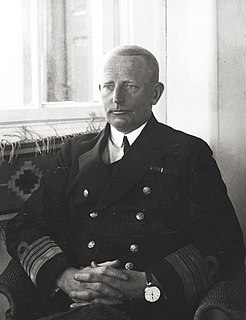
Józef Unrug was a Polish admiral who helped reestablish Poland's navy after World War I. During the opening stages of World War II, he served as the Polish Navy's commander-in-chief. As a German POW, he refused all German offers to change sides and was incarcerated in several Oflags, including Colditz Castle. He stayed in exile after the war in the United Kingdom, Morocco and France where he died and was buried. In September 2018 he was posthumously promoted in the rank of Admiral of the fleet by the President of Poland. After 45 years his remains, along with those of his wife Zofia, were exhumed from Montrésor and taken in October 2018 to his final resting place in Gdynia, Poland.
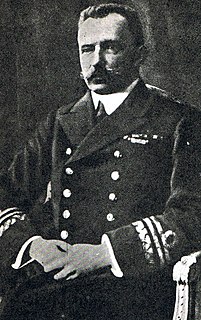
Kazimierz Porębski was a Polish career naval officer who rose to the position of admiral within the Imperial Russian Navy, and was subsequently the first commander-in-chief of the inter-war Polish Navy.
ORP Gryf was a school and hospital ship of the Polish Navy, a second vessel to bear that name. She was built in German-occupied Denmark as a cargo ship in 1944, shortly before the end of World War II and initially named Irene Oldendorff. Soon after the capitulation of Germany, she was taken by the United Kingdom, passed to the Ministry of War Transport (MoWT) and renamed Empire Contees, but in 1946 it was given to the Soviet Union as part of that country's war reparations from Germany. Renamed Omsk (Омск), she served in the Soviet merchant fleet until 1947 when she was sold to Poland.

ORP Sokół was a U-class submarine built by Vickers-Armstrong at Barrow-in-Furness. Shortly after launching in September 1940 she was to be commissioned by the Royal Navy as HMS Urchin, but instead was leased to the Polish Navy due to a lack of experienced submarine crews. A sister boat to Dzik, both boats operated in the Mediterranean from Malta, where they became known as the "Terrible Twins".
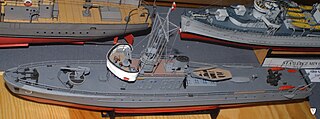
ORP Jaskółka was the lead ship of her class of minesweepers in the Polish Navy at the outset of World War II. Jaskółka was sunk during the Nazi invasion of 1939.

Kontradmirał Włodzimierz Steyer was a Polish naval officer before and during the Second World War. During the Invasion of Poland in 1939 he commanded the Polish land forces defending the Hel Peninsula in what became known as the Battle of Hel, the longest-lasting battle of the campaign. After the war he briefly served as the commanding officer of the entire Polish Navy. Steyer was also an author of novels under the pen-name "Brunon Dzimicz".
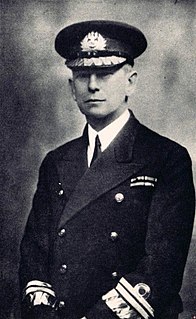
Jerzy Włodzimierz Świrski was a Polish vice admiral and officer in the Russian Imperial Navy and later the Polish Navy. As Chief of the Polish Naval Command (1925-1947), he was a member of an elite group of high ranking Polish naval officers from foreign navies who became founder members of the re-established naval forces of the newly independent Poland after World War I. During World War II, Polish naval forces under his command, were embedded with the Royal Navy and contributed significantly to the success of Britain's maritime war effort. He notably fell out with Poland's war time Prime Minister-in-exile, General Sikorski, but was backed by the British and survived in post. He was appointed an Honorary Knight Commander of the Order of the Bath.

A merchant navy or merchant marine is the fleet of merchant vessels that are registered in a specific country. On merchant vessels, seafarers of various ranks and sometimes members of maritime trade unions are required by the International Convention on Standards of Training, Certification and Watchkeeping for Seafarers (STCW) to carry Merchant Mariner's Documents.

Adam Mohuczy (1891–1953) was a Polish Navy officer. Captain of several ships and squadrons, Counter Admiral from 1946 and Chief of Staff and Commander of the Polish Navy from 1945–1947. In 1949 arrested by Polish secret police, accused of sabotage, tortured. He died in prison in 1953. In 1957 he was rehabilitated.

Polska Żegluga Morska known as Polsteam or PŻM, is a cargo ship operator based in Szczecin, Poland. Polsteam is a state-owned enterprise with around 3,000 employees.

Hel Lighthouse is an active lighthouse in the town of Hel, Pomeranian Voivodeship in Poland. It is situated at the eastern tip of the Hel Peninsula and guides ship traffic into Gdańsk Bay and the Bay of Puck.
The Maritime and Colonial League was a mass Polish social organization, created in 1930 out of the Maritime and River League. In the late 1930s it was directed by general Mariusz Zaruski and its purpose was to educate the Polish nation about maritime issues. It also actively supported the development of both a merchant fleet and large navy, as well as the creation of Polish colonies and overseas possessions.
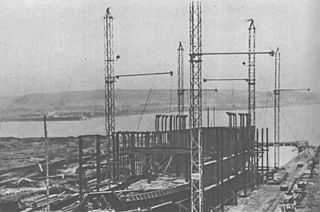
SS Olza was the first dry cargo freighter built in Poland after the country regained independence in 1918, and the only large commercial ship built before World War II. Owned by the Żegluga Polska company, she was named after the Olza River which flows through Cieszyn Silesia.

Andrzej Antoni Jaraczewski, nickname Andrew, was a Polish Navy officer.

The Polish Navy is the naval branch of the Polish Armed Forces. The Polish Navy consists of 46 ships and about 12,000 commissioned and enlisted personnel. The traditional ship prefix in the Polish Navy is ORP.

The Armed Forces of the Republic of Poland are the national armed forces of the Republic of Poland. The name has been used since the early 19th century, but can also be applied to earlier periods.

The MS Morska Wola,, was a Polish freighter during the Second World War. She was purchased in Norway by the Polish shipping company Gdynia America Line and named after a Polish emigrants settlement in Brazil.

Kołobrzeg Lighthouse is a lighthouse in Kołobrzeg on the Polish coast of the Baltic Sea. The lighthouse in located in Kołobrzeg, West Pomeranian Voivodeship; in Poland.

Bolesław Romanowski was a submarine commander of the Polish Navy during World War II.

Eugeniusz Józef Stanisław Pławski was a Polish Navy officer who served in World War I and World War II. He was the commander of the ORP Piorun (G65) during the hunt for Bismarck.



















